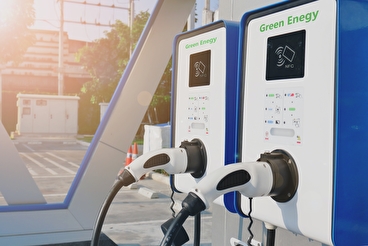
An Equitable Transition to Decarbonized Transportation

Will Northrop, Director, Thomas E. Murphy Engine Research Laboratory
Areas of Expertise: Connected Vehicles & Applied Thermodynamics
The accelerating global transition to vehicle electrification is motivated by the need to decarbonize transportation. While this transition will create new economic opportunities, it also presents an opportunity to reduce the negative health impacts caused by the current dominance of fossil-fuel-powered transportation. Currently, more than 1.4 billion vehicles are estimated to be in use globally; fewer than 1 percent of them are powered solely by electricity. Electrifying the entire road transportation sector, from e-bikes to heavy-duty trucks, is an immense challenge that will require technology breakthroughs for both electric vehicles (EVs) and the infrastructure they travel on. This transition will also require careful consideration of how the system will be deployed equitably to ensure that all communities can benefit from it.
A significant research effort is needed to investigate how government intervention, the placement of charging infrastructure, and investment in renewable power generation could result in a fairer and more just transition to transportation electrification.

Infrastructure and investments to support the equitable adoption of EVs will be a critical first step. Even as battery costs decrease and more cost-effective EVs are introduced, challenges remain for many to access this technology. For example, households without reliable at-home charging and small businesses with limited resources to support commercial EV infrastructure each face difficult transitions without appropriate support. Important first steps, such as using tools that identify locations for investment in charging infrastructure to ensure fair EV access, are already in use. However, future analysis is also required to ensure that increasing the number of EVs on the road does not further harm those in disadvantaged communities—through increased emissions of greenhouse gasses or conventional pollutants from additional fossil electricity production.
One underutilized aspect of EVs that could help refine the system buildout with an eye toward equity and access is the use of onboard vehicle data (OVD). OVD includes Global Positioning System location, powertrain parameters, and other associated data typically used to optimize individual vehicle performance. This is a missed opportunity. In recent years, artificial intelligence models trained using OVD have been employed by manufacturers to estimate when a vehicle will need to be charged. Such information is vital for user comfort with EVs and could help inform both charging locations and user confidence. Going further, the OVD models could be improved by incorporating estimates of important physical vehicle parameters, such as vehicle mass—a significant feature of heavy-duty commercial vehicles. Vehicle data could also be used to determine where infrastructure should be placed for maximum benefit to all drivers and to estimate emission hotspots that would result from generating the electricity needed for EV charging.
While public EV charging stations are becoming more commonplace, their distribution—like that of EVs themselves—has been vastly uneven and skewed towards wealthier, highly populated areas and areas with strong government initiatives. This focus leaves many consumers without suitable charging options. Previous studies have considered how chargers could be placed to support as many EVs or routes as possible, but few put equity of access to chargers at their core. OVD collected by manufacturers and resold by third parties could be used to track charging patterns in households without access to at-home chargers to inform more equitable distribution of inexpensive charging stations. However, OVD and tools used to analyze charging decisions should be democratized such that small fleet operators and municipalities could optimize their operations without additional cost and complexity.
Beyond determining equitable access to charging in disadvantaged communities, the power generation infrastructure required to feed electric vehicles should also be considered. Increased demand for electricity to serve the growing EV charging network will require new electricity-generating facilities. What the subsequent impact of these facilities would be on community-level emissions from harmful pollutants like nitrogen oxides and particulate matter, and where those negative impacts would fall, are critical equity questions. This is especially pertinent in locations that have a high proportion of historically disadvantaged communities, a combustion-heavy energy mix, significant electricity generation, and very little public charging infrastructure. If EV adoption increases rapidly in such areas, communities with access to EVs should see an improvement in air quality from reduced tailpipe emissions—but areas near combustion-based power plants might see a simultaneous increase in emissions as energy production rises to meet demand. A significant research effort is needed to investigate how government intervention, the placement of charging infrastructure, and investment in renewable power generation could result in a fairer and more just transition to transportation electrification.
The EV transition has much to offer to the American transportation system, but care must be taken to ensure we are placing the supportive infrastructure equitably. Developing a deep understanding of OVD and what use patterns show us about the ways EVs are deployed by drivers can provide an important foundation for building a system that works for all.